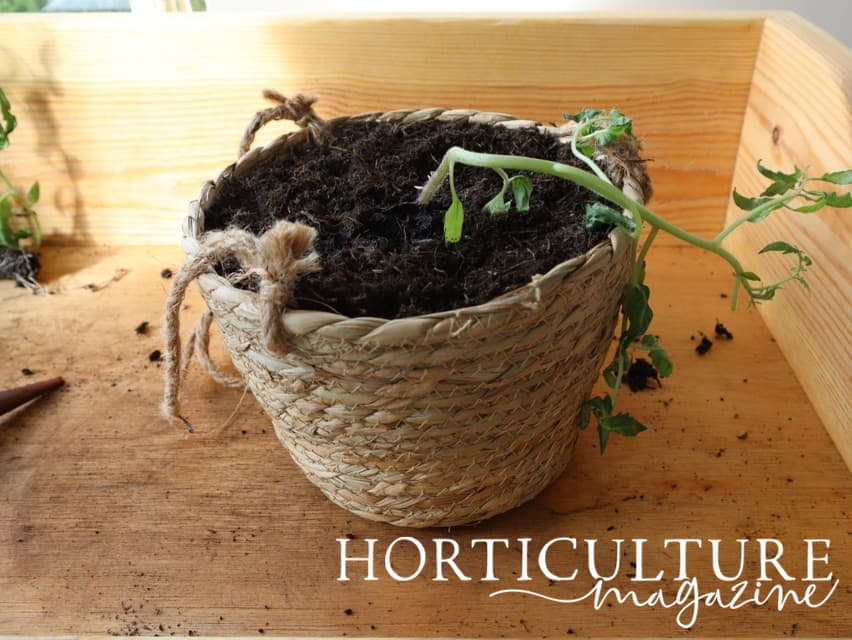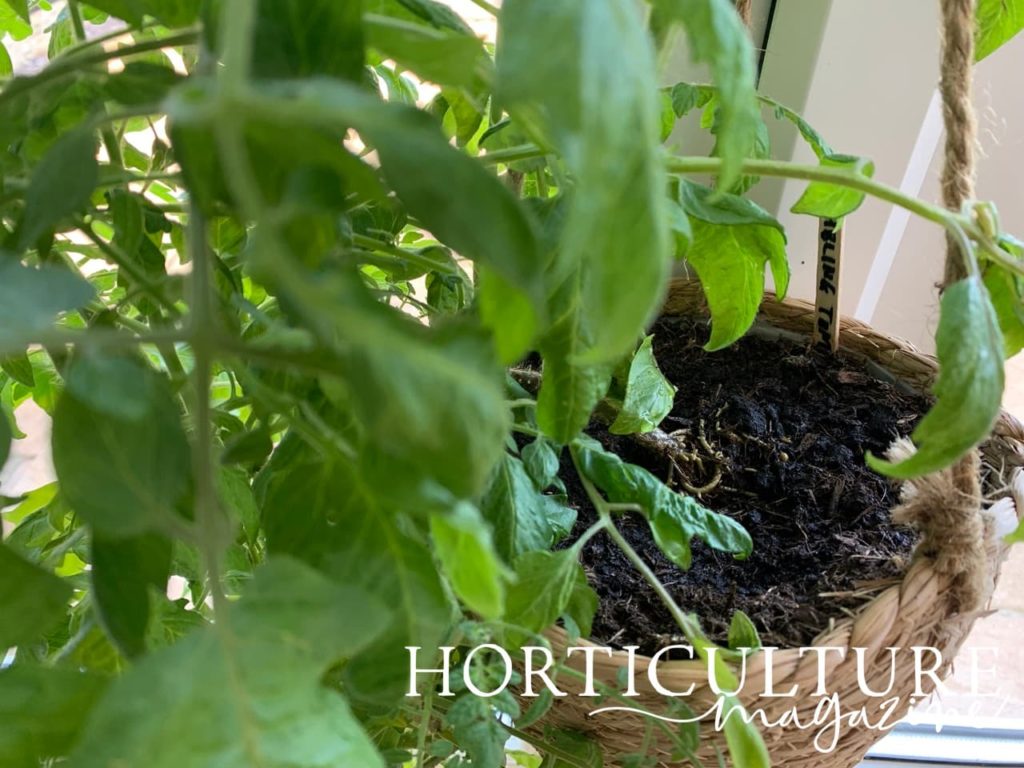FRUIT > TOMATOES > HANGING-BASKETS
Chris is a gardening writer and nature enthusiast. He graduated from Oxford Brookes University in 2022 with an MA in Psychology. Chris works with the Leeds Green Action Society, helping their food cooperative by growing various fruit and vegetables on their two allotments in Hyde Park, Leeds.
Reviewed By PETER LICKORISH

Peter is a Horticulture Lecturer and self-employed Horticulturist, with a passion for diverse areas of the industry - from garden design to the science behind plant growth and propagation. He has completed the Royal Horticultural Society’s Master of Horticulture (MHort) Award and lectures on RHS courses at Bedford College.
IN THIS GUIDE
- Why Choose Hanging Baskets?
- How To Grow Tomatoes In Hanging Baskets
- 1) Choose Your Variety
- 2) Sow Your Seeds
- 3) Choose Your Hanging Basket
- 4) Line Your Basket
- 5) Prepare Your Compost
- 6) Plant Your Tomatoes
- 7) Hang Your Toms In Their New Home
- 8) Water Regularly
- 9) Harvest!
- Which Tomatoes Can You Grow In A Hanging Basket?
- Companion Plants For Tomatoes
- Let It All Hang Out!
- References
TOMATO GUIDES
Disposal
Feeding
Growing From Seed
Growing In Hanging Baskets
Harvesting
Problems
– Not Setting Fruit
Pruning
Yellow / Orange Varieties
– Roma
– Sungold
– Alicante
– Moneymaker
– Gardeners Delight
There’s nothing tastier than a nicely ripened home-grown tomato.
They’re juicier, stronger tasting, and more vibrantly coloured than the ones you find in supermarkets which – let’s face it – are sometimes bordering on anaemic.
But how do you grow tomatoes in hanging baskets? What’s required to achieve your own tumbling cornucopia of juicy garden goodness?
We’ve written this guide to answer all the questions you might have about growing tomatoes in a hanging basket.

Why Choose Hanging Baskets?
Not everyone with a green thumb has access to a garden, or even to an allotment or other shared gardening space.
For those amongst us with balconies or whose front doors open right onto the street, the solution lies elsewhere.
A hanging basket is a great space-saving gardening solution.

You can grow a surprising amount in a compact space.
You can hang baskets from purpose-built hooks mounted on walls, or from existing surfaces like beams, branches, rafters, and more.
If you’re a more casual gardener and you don’t want to commit to hardcore gardening, hanging baskets are less prone to weeds and pests.
Slugs and snails find it harder to reach the tasty morsels growing within, and although flying pests can find their way up, you can grow scented plants alongside your tomatoes to put them off.
More on that later!
How To Grow Tomatoes In Hanging Baskets
Maybe you’ve not grown an edible hanging basket before?
Fret not: It’s quick and cheap to set up, and it’s easy enough to be accessible for gardeners of any level.
Here are nine steps to growing tomatoes in a hanging basket:
1) Choose Your Variety

It’s important you choose a variety of tomato that is well suited to hanging baskets.
Ordinary tomatoes such as ‘Gardener’s Delight’ are typically staked and will need support as they grow upwards, meaning they are not suited to growing in hanging baskets.
Varieties that are best for hanging baskets include ‘Tumbling Tom’, ‘Hundreds & Thousands’, ‘Garden Pearl’ and more. These are bush or indeterminate varieties.
For the purposes of this guide, we decided to grow ‘Tumbling Toms’, which are widely available here in the UK.
2) Sow Your Seeds

Your seeds will need to be grown indoors in the UK – with February being the best time to get started.
Tomatoes love a lot of light and a humid, moist environment, so a propagator with LED lighting will provide the best results.

Sow multiple seeds per plug and thin these out as they begin to grow, choosing to spare the strongest seedlings.

3) Choose Your Hanging Basket
There are tons of hanging baskets available to buy online.
Many are semi-spherical and made of thin metal wiring.
We recommend a basket of 35cm in diameter or above to give your tomato plants the space they need to grow.
Choose a deeper basket too, if possible, as this will help with moisture retention – as long as your brackets are strong enough!
In this example, we chose a wicker basket suited for indoor growing.
4) Line Your Basket
Some baskets come with lining already.
If your basket has a solid brown layer on top of the metal frame, for example, this is probably coconut coir (or fibre).
If this is the case, you don’t need to add anything else.
If your basket doesn’t come pre-lined, you can use a compost or soil bag that’s been cut to size.
Make sure to add some small holes to give your tomatoes the chance to drain.
5) Prepare Your Compost

Potting soil will do the trick here. Make sure it’s good quality.
Preparing the compost can be as simple as checking you have enough to fit in your basket.
A 35cm basket will hold just under 8 litres of compost and a 40 litre bag of potting soil will fill about five baskets.
There are a few optional extras at this step, too. Each of these will give your tomatoes an easier time:
- Water retaining gel: This will allow water to be released more slowly than otherwise, ensuring your plants stay hydrated
- Rotted leaf mould: A natural alternative to the above.
- Slow-release fertiliser: To add a steady stream of nutrients to the soil while your tomatoes are growing.
6) Plant Your Tomatoes

Here’s the main event! In this step, we’ll plant out the tomatoes into their lovely new home.
Gently remove the tomato plant from its pot, along with the soil and roots.
Tease the roots away from the clump of soil to prevent cramping and promote healthier root growth.
Next, create a hollow in the soil with your fingers and pop the tomato inside.

Firm up the soil around the roots, so that your tomatoes are firmly in place but not squashed. You can add more soil at this stage if needed.
Tomato plants will do well if they’re planted reasonably deep, as they’re prone to put out strong roots.
You can safely fit one or two plants into a 35cm hanging basket, although Master Horticulturist Peter Lickorish does not recommend this:
“Besides other companion plants, one tomato plant is probably the maximum for most hanging baskets, unless the diameter is nudging 50cm, where a triangle of three could be planted.”
7) Hang Your Toms In Their New Home

Use the chain or similar method of attachment to hang your basket – and take a moment to appreciate your handiwork.
(You can also use this moment to make sure the hook is definitely strong enough to hold the completed basket..!)
8) Water Regularly

Once planted, give your tomato plant a generous amount of water.
The roots will be thirstiest at this stage, so you’re giving them the best chance of a healthy start in life.
For the first week or so, we recommend watering your tomato plant every day.

Also, keep an eye out for flowers, and add tomato feed once they begin to appear.
Reapplying feed each week will give you healthy and delicious tomatoes in no time.
9) Harvest!

Once your tomatoes are ready to eat, it’s just a case of picking them as and when you fancy.
They last quite a long time on the plant so don’t feel rushed to pick your tomatoes.
Generally, it’s better to leave them ripening on the plant than sitting in the fridge.
However, they will ripen further after picking, if harvested early, and this may reduce the chance of fruit splitting.
If it’s the first time you’ve grown your own tomatoes, savour each bite and enjoy how juicy and succulent they are.
Which Tomatoes Can You Grow In A Hanging Basket?

Regular tomato plants won’t thrive in baskets. For the best results, choose a cherry tomato variety.
Tomatoes that lend themselves best to hanging baskets have been bred to tumble, meaning they don’t need to be supported while growing.
Some types also crop earlier in the year than ground equivalents, meaning you can enjoy tomatoes for more of the year.
Here are a few varieties to consider:
- ‘Hundreds and Thousands’: Sweet and noted to be particularly flavoursome by a trained panel of tomato tasters, this variety is a good bet for hanging baskets. Just understand that ‘thousands’ is a name, not a promise of yield.
- ‘Tumbling Tom’: Whether you choose ‘Tumbling Tom Red’, Yellow, or both, you can expect a flavourful and confident crop. Mixing the two varieties together gives the excellent potential for a particularly colourful display.
- ‘Maskotka’: Renowned for deep-red fruits that tumble elegantly over the sides of a basket, ‘Maskotka’ is a great choice for vertical gardeners. You can expect a fairly large yield, too, especially compared with some other types.
- ‘Garden Pearl’: The heart-shaped fruits win plaudits from the tomato-tasting panel who liked ‘Hundreds and Thousands’ so much. If you want a tomato with its own brand of visual interest, ‘Garden Pearl’ could be for you.
A few more varieties were tasted by the panel mentioned above, and the article makes such quaint reading that we recommend you take a look for yourself.1Best tomatoes for hanging baskets. (2009, March 28). The Telegraph. Retrieved March 27, 2023, from https://www.telegraph.co.uk/gardening/gardeningadvice/5054902/Best-tomatoes-for-hanging-baskets.html
Tomato plants will grow best in baskets when they’re planted in early summer.
Frost can be fatal for fledgeling flowers, so planting them out when the weather is warmer gives the best chance for a healthy start in life.
A hanging basket is more exposed to the weather than a plant in the ground, so if there are particularly chilly winds when you’re thinking of planting, maybe wait a few days.
Companion Plants For Tomatoes

You can add other plants to your hanging basket, too.
If the intent behind your basket is to bring colour and visual interest to an outdoor space, there are aesthetic considerations.
Plants with complementary colours will look great alongside your tomatoes.
Oranges, yellows, and reds will create medleys of colour that are a pleasure to behold.
If you’re motivated mainly by the culinary eventualities, though, then taste and scent considerations will probably be a priority.
You can choose plants whose flavours work well with tomato when cooking. Basil, for example, or any of myriad salad leaves.

In terms of scent, I will commonly grow French Marigolds alongside tomatoes grown outside, as these are a very good match.
They carry the additional benefit of deterring flying pests, too.
Let It All Hang Out!

As you can probably tell, there are a lot of options when growing tomatoes in hanging baskets.
You need to decide which variety to grow and whether to grow them alone or with other plants.
You need to decide the best place to hang your basket, and the type of basket you want in the first place.
Hopefully, after reading this guide, though, you’ll realise that the underlying methodology for growing tomatoes in baskets is simple.
It’s quick, cheap, and the return on investment is potentially enormous.
We hope you’ve found this guide useful, and that you enjoy many a bountiful tomato harvest from your newly planted baskets.
References
- 1Best tomatoes for hanging baskets. (2009, March 28). The Telegraph. Retrieved March 27, 2023, from https://www.telegraph.co.uk/gardening/gardeningadvice/5054902/Best-tomatoes-for-hanging-baskets.html

